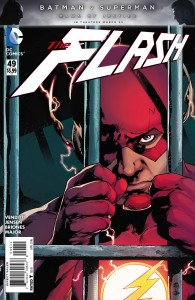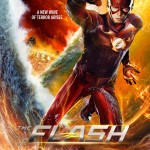Here’s the extended trailer for the next episode of The Flash, titled “Trajectory”. It won’t air until March 22nd, so we’ve got a while to wait.
Spoilers for this week’s episode behind the jump!

Here’s the extended trailer for the next episode of The Flash, titled “Trajectory”. It won’t air until March 22nd, so we’ve got a while to wait.
Spoilers for this week’s episode behind the jump!
 The Mayor of Central City has given the order – bring in the Flash! And to do it, the CCPD must make a deal with…the Rogues! How topsy-turvy is this? Now, Barry Allen, CSI must help the Rogues track down Public Enemy #1…himself! That’s where we pick up with THE FLASH #49! Want to know more? Just follow us after the jump!
The Mayor of Central City has given the order – bring in the Flash! And to do it, the CCPD must make a deal with…the Rogues! How topsy-turvy is this? Now, Barry Allen, CSI must help the Rogues track down Public Enemy #1…himself! That’s where we pick up with THE FLASH #49! Want to know more? Just follow us after the jump!
SOME SPOILERS AHEAD!
If you thought this was going to be a “filler” episode, bringing back a fan-favorite character for an encore but not doing much of substance…surprise! Episode 2.15 of THE FLASH is in many ways one of the best episodes of the season, with exceptional CG, great cameos, and significant plot points that will leave your jaw hitting the floor! Want to know more? Just follow after the jump!
SPOILERS AHEAD – YOU HAVE BEEN WARNED!
This week’s Flash #49 has a variant cover by Neal Adams and Frank Miller, inspired by Adams’ cover for Superman #317. The 13th Dimension interviews Neal Adams about the cover process and working with Miller, and shows different stages of the art process.
 Here’s a new poster for this week’s episode of The Flash, titled “King Shark”. It’s obviously meant to evoke a nautical disaster movie, which we’ll undoubtedly be seeing in the episode.
Here’s a new poster for this week’s episode of The Flash, titled “King Shark”. It’s obviously meant to evoke a nautical disaster movie, which we’ll undoubtedly be seeing in the episode.
And you can see some official stills from it at CBR.
It’s apparent that there’ll be a break after this week’s episode, although I don’t know how long the hiatus will last. This week’s will be episode fifteen, which leaves eight remaining afterwards. It sounds like the next few won’t have a lot to do with Zoom, but I’d imagine they’ll be picking up the story arc sometime soon.
Looking forward to the return of King Shark? Feel free to share your thoughts!
DC Universe: Rebirth is revealed. After the New 52 line reaches issue #52 in May, an 80-page special “DC Universe: Rebirth” sets the stage for a rolling update of the new DC line:
Flash: Rebirth and Flash #1 both hit in June. Both? Yep, Flash is one of the 17 comics that will ship twice a month.
As for the shape of the DC Universe going forward, Dan Didio says it’s “designed to bring back the best of DC’s past, embrace the stories we currently love and move the entire epic universe into the future. We are returning to the essence of the DCU.”
CBR has an interview with Geoff Johns in which he says it’s less like “Crisis” or “Flashpoint,” and more like “Green Lantern: Rebirth” and “Flash: Rebirth.”
“DC Universe: Rebirth” is about bringing back what makes the DC Universe the DC Universe. There are certain things, like legacy, that are missing. There are other things that I don’t want to totally spoil. But there are a lot of things in there that I think are unique to the DC Universe, and really need to be pushed back to the forefront.
DC continues to insist that they’re not going for a total reboot. It sounds more like they’re re-incorporating parts of the DCU that the New 52 abandoned. A merging of the pre-Flashpoint and New 52 universes, perhaps? (The new line does include Gotham Academy and Red Hood & the Outlaws.)
CBR has the full list of titles in the new lineup.
I’m really not sure what to think at this point. Knowing the titles is one thing. What I really want to know is the tones they’re going for, what elements are staying, going, or returning, who’s working on these books, etc. Also the page count: If they’re cutting pages again, going twice-monthly isn’t quite as appealing.
I do think that launching with a one-shot instead of dragging out the transformation over six months to a year is a good move. I frankly don’t have the patience to drag myself through six issues of rearranging furniture again. Conversely, I also think it’s a good idea to stagger the roll-out so that people aren’t overwhelmed by 52 choices in one month.
What do you think, based on what we know so far? Good move? Bad? Reply hazy, try again?